SATURN ION 2004 Manual Online
Manufacturer: SATURN, Model Year: 2004, Model line: ION, Model: SATURN ION 2004Pages: 380, PDF Size: 2.89 MB
Page 81 of 380
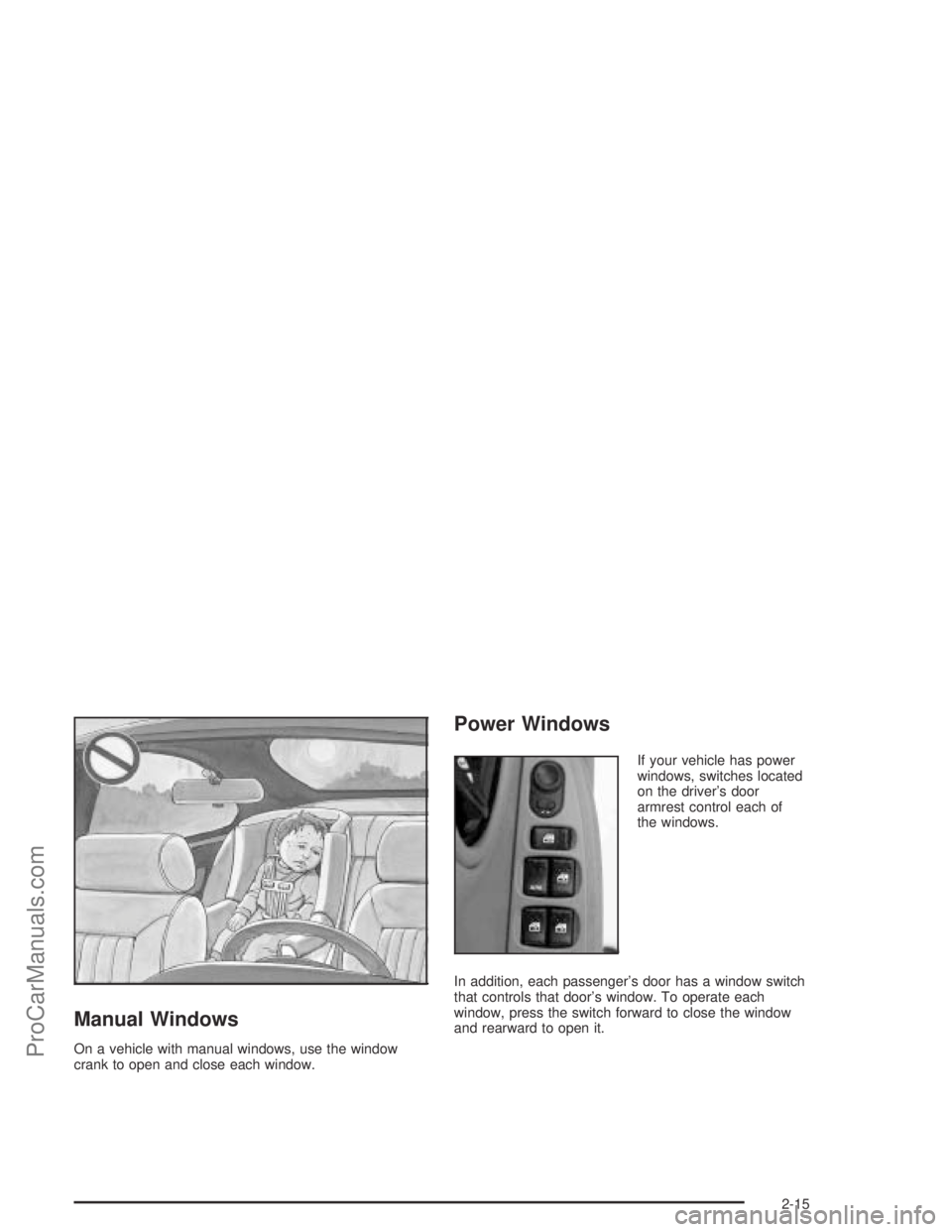
Manual Windows
On a vehicle with manual windows, use the window
crank to open and close each window.
Power Windows
If your vehicle has power
windows, switches located
on the driver’s door
armrest control each of
the windows.
In addition, each passenger’s door has a window switch
that controls that door’s window. To operate each
window, press the switch forward to close the window
and rearward to open it.
2-15
ProCarManuals.com
Page 82 of 380
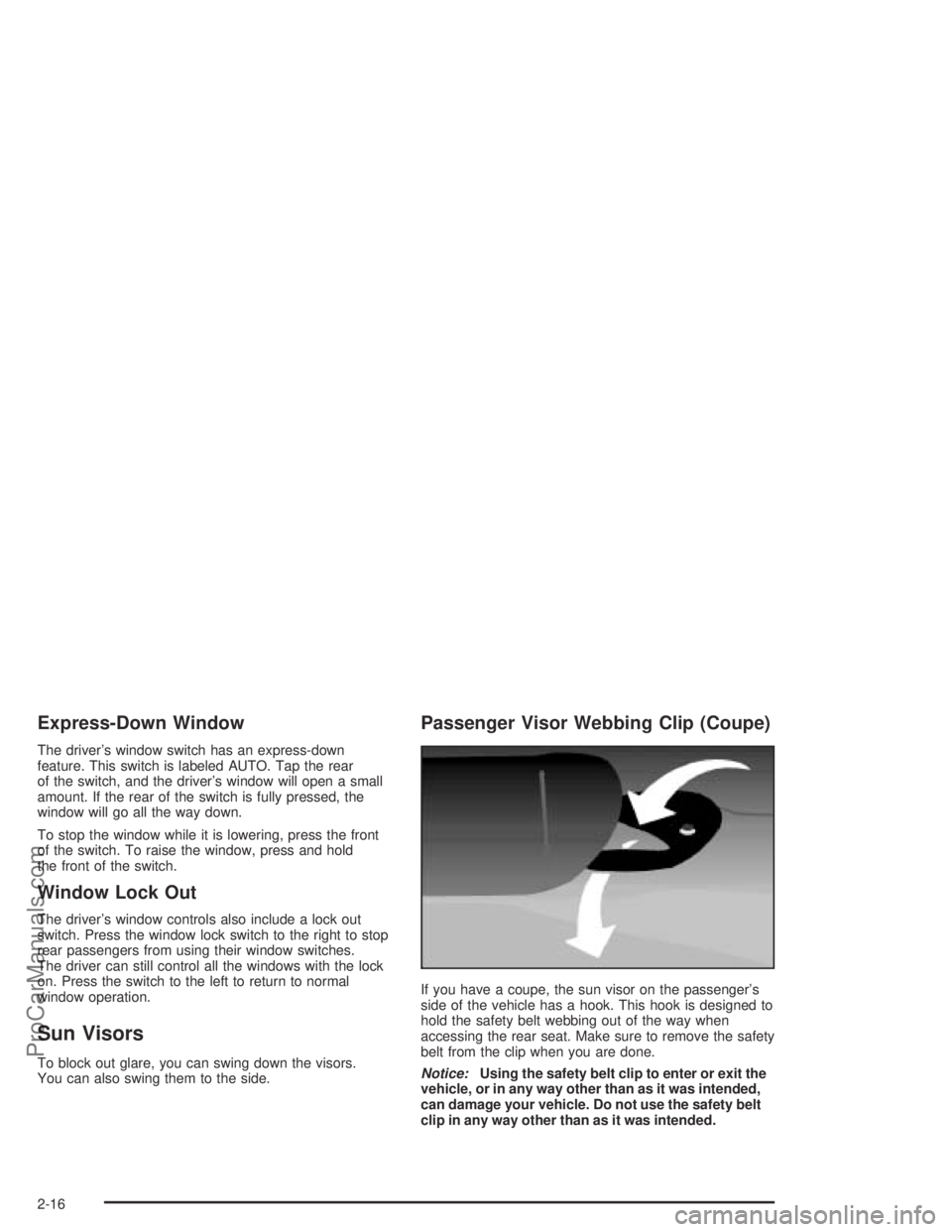
Express-Down Window
The driver’s window switch has an express-down
feature. This switch is labeled AUTO. Tap the rear
of the switch, and the driver’s window will open a small
amount. If the rear of the switch is fully pressed, the
window will go all the way down.
To stop the window while it is lowering, press the front
of the switch. To raise the window, press and hold
the front of the switch.
Window Lock Out
The driver’s window controls also include a lock out
switch. Press the window lock switch to the right to stop
rear passengers from using their window switches.
The driver can still control all the windows with the lock
on. Press the switch to the left to return to normal
window operation.
Sun Visors
To block out glare, you can swing down the visors.
You can also swing them to the side.
Passenger Visor Webbing Clip (Coupe)
If you have a coupe, the sun visor on the passenger’s
side of the vehicle has a hook. This hook is designed to
hold the safety belt webbing out of the way when
accessing the rear seat. Make sure to remove the safety
belt from the clip when you are done.
Notice:Using the safety belt clip to enter or exit the
vehicle, or in any way other than as it was intended,
can damage your vehicle. Do not use the safety belt
clip in any way other than as it was intended.
2-16
ProCarManuals.com
Page 83 of 380

Theft-Deterrent Systems
Vehicle theft is big business, especially in some cities.
Although your vehicle has a number of theft-deterrent
features, we know that nothing we put on it can make it
impossible to steal.
Passlock®
Your vehicle is equipped with the Passlock®
theft-deterrent system.
Passlock
®is a passive theft-deterrent system.
Passlock®enables fuel if the ignition lock cylinder is
turned with a valid key. If a correct key is not used or the
ignition lock cylinder is tampered with, fuel is disabled.
During normal operation,
the security light will
go off approximately �ve
seconds after the key
is turned to the RUN
ignition position following
an engine start.If the engine stalls and the security light �ashes, wait
until the light stops �ashing before trying to restart
the engine. Remember to release the key from START
as soon as the engine starts.
If the engine is running and the security light comes on,
you will be able to restart the engine if you turn the
engine off. However, your Passlock
®system is
not working properly and must be serviced by your
retailer. Your vehicle is not protected by
Passlock
®at this time. You may also want to check the
fuses, seeFuses and Circuit Breakers on page 5-95.
See your retailer for service.
2-17
ProCarManuals.com
Page 84 of 380

Starting and Operating
Your Vehicle
New Vehicle Break-In
Notice:Your vehicle does not need an elaborate
“break-in.” But it will perform better in the long run
if you follow these guidelines:
Do not drive at any one speed — fast or
slow — for the �rst 500 miles (805 km).
Do not make full-throttle starts.
Avoid making hard stops for the �rst 200 miles
(322 km) or so. During this time your new brake
linings are not yet broken in. Hard stops with new
linings can mean premature wear and earlier
replacement. Follow this breaking-in guideline
every time you get new brake linings.
Do not tow a trailer during the �rst 1,000 miles
(1 600 km). SeeTowing a Trailer on page 4-39for
more information.
Ignition Positions
With the key in the ignition switch, you can turn it to four
different positions.
Notice:If your key seems stuck in LOCK and you
can not turn it, be sure you are using the correct
key; if so, is it all the way in? If it is, then turn the
steering wheel left and right while you turn the
key hard. Turn the key only with your hand. Using a
tool to force it could break the key or the ignition
switch. If none of these works, then your vehicle
needs service.
2-18
ProCarManuals.com
Page 85 of 380
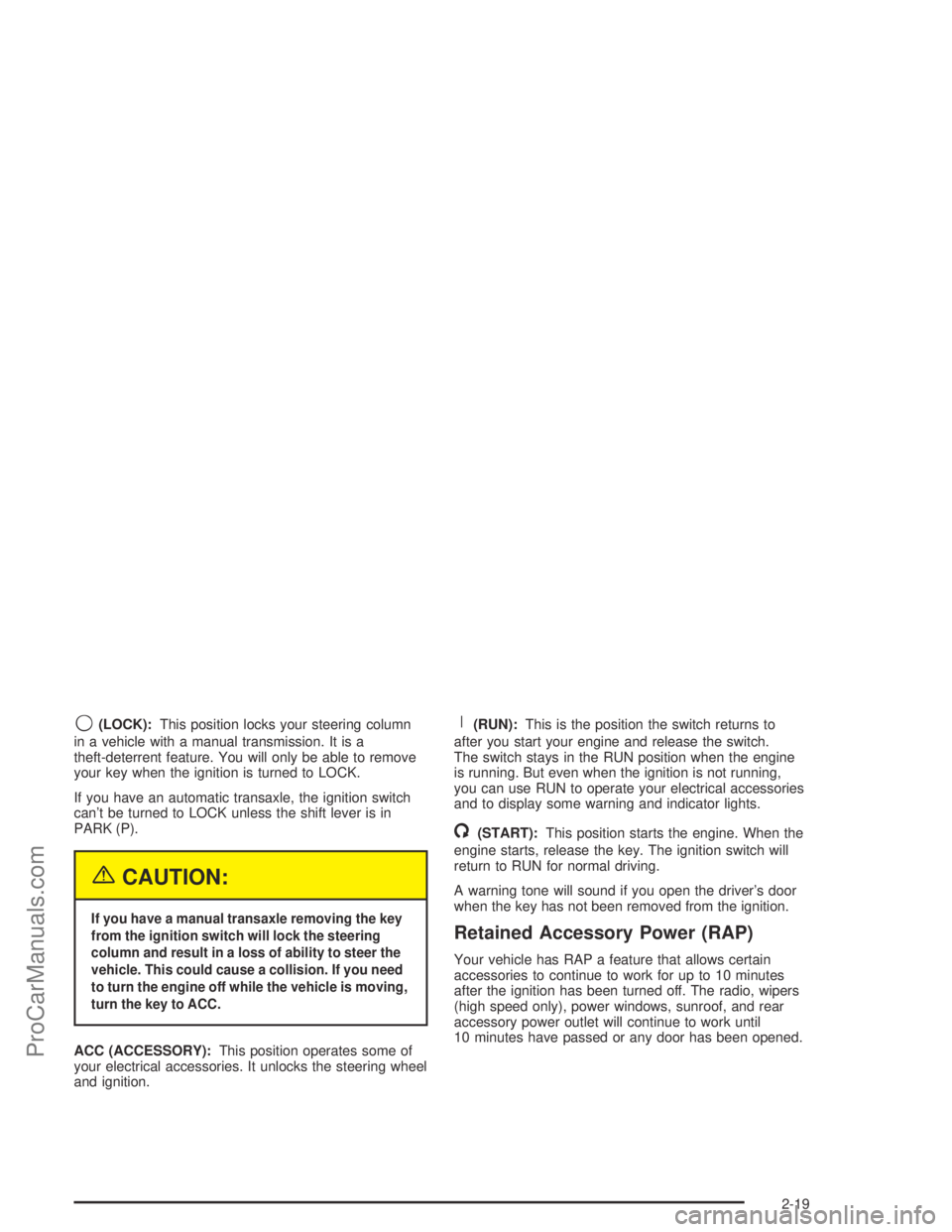
9(LOCK):This position locks your steering column
in a vehicle with a manual transmission. It is a
theft-deterrent feature. You will only be able to remove
your key when the ignition is turned to LOCK.
If you have an automatic transaxle, the ignition switch
can’t be turned to LOCK unless the shift lever is in
PARK (P).
{CAUTION:
If you have a manual transaxle removing the key
from the ignition switch will lock the steering
column and result in a loss of ability to steer the
vehicle. This could cause a collision. If you need
to turn the engine off while the vehicle is moving,
turn the key to ACC.
ACC (ACCESSORY):This position operates some of
your electrical accessories. It unlocks the steering wheel
and ignition.
R(RUN):This is the position the switch returns to
after you start your engine and release the switch.
The switch stays in the RUN position when the engine
is running. But even when the ignition is not running,
you can use RUN to operate your electrical accessories
and to display some warning and indicator lights.
/(START):This position starts the engine. When the
engine starts, release the key. The ignition switch will
return to RUN for normal driving.
A warning tone will sound if you open the driver’s door
when the key has not been removed from the ignition.
Retained Accessory Power (RAP)
Your vehicle has RAP a feature that allows certain
accessories to continue to work for up to 10 minutes
after the ignition has been turned off. The radio, wipers
(high speed only), power windows, sunroof, and rear
accessory power outlet will continue to work until
10 minutes have passed or any door has been opened.
2-19
ProCarManuals.com
Page 86 of 380

Starting Your Engine
Automatic Transaxle
Move your shift lever to PARK (P) or NEUTRAL (N).
Your engine won’t start in any other position — that’s a
safety feature. To restart when you’re already moving,
use NEUTRAL (N) only.
Notice:Shifting into PARK (P) with the vehicle
moving could damage the transaxle. Shift into
PARK (P) only when your vehicle is stopped.
Manual Transaxle
The gear selector should be in NEUTRAL and the
parking brake engaged. Hold the clutch pedal to the �oor
and start the engine. Your vehicle won’t start if the
clutch pedal is not all the way down – that’s a safety
feature.
Starting Your Engine
1. With your foot off the accelerator pedal, turn your
ignition key to START. When the engine starts, let
go of the key. The idle speed will go down as
your engine gets warm.
Notice:Holding your key in START for longer than
15 seconds at a time will cause your battery to
be drained much sooner. And the excessive heat
can damage your starter motor. Wait about
15 seconds between each try to help avoid draining
your battery or damaging your starter.
2. If it doesn’t start, wait about 15 seconds and try
again to start the engine by turning the ignition
key to START. Wait about 15 seconds between
each try.
When your engine has run about 10 seconds to
warm up, your vehicle is ready to be driven.
Don’t “race” your engine when it’s cold.
If the weather is below freezing (32°F or 0°C),
let the engine run for a few minutes to warm up.
2-20
ProCarManuals.com
Page 87 of 380
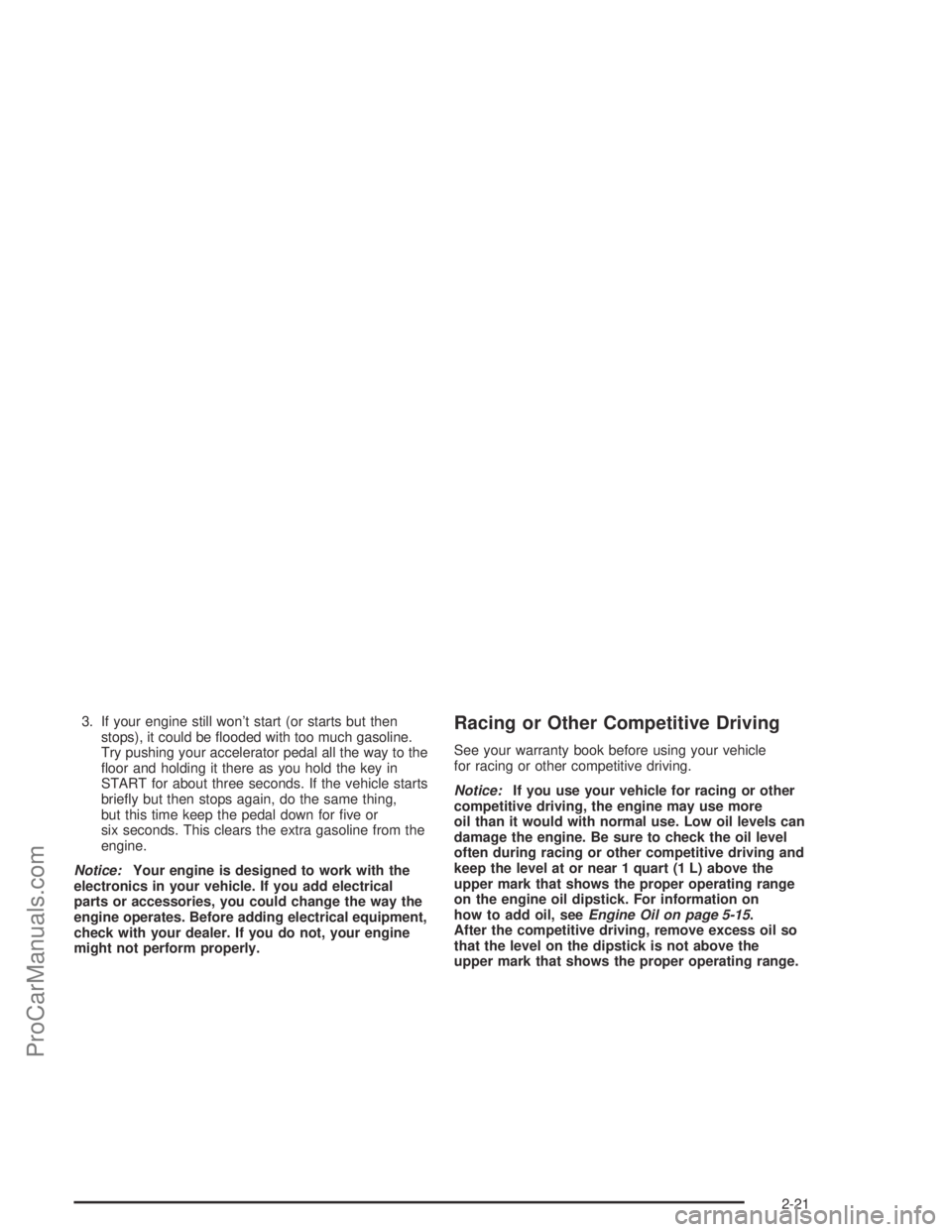
3. If your engine still won’t start (or starts but then
stops), it could be �ooded with too much gasoline.
Try pushing your accelerator pedal all the way to the
�oor and holding it there as you hold the key in
START for about three seconds. If the vehicle starts
brie�y but then stops again, do the same thing,
but this time keep the pedal down for �ve or
six seconds. This clears the extra gasoline from the
engine.
Notice:Your engine is designed to work with the
electronics in your vehicle. If you add electrical
parts or accessories, you could change the way the
engine operates. Before adding electrical equipment,
check with your dealer. If you do not, your engine
might not perform properly.Racing or Other Competitive Driving
See your warranty book before using your vehicle
for racing or other competitive driving.
Notice:If you use your vehicle for racing or other
competitive driving, the engine may use more
oil than it would with normal use. Low oil levels can
damage the engine. Be sure to check the oil level
often during racing or other competitive driving and
keep the level at or near 1 quart (1 L) above the
upper mark that shows the proper operating range
on the engine oil dipstick. For information on
how to add oil, seeEngine Oil on page 5-15.
After the competitive driving, remove excess oil so
that the level on the dipstick is not above the
upper mark that shows the proper operating range.
2-21
ProCarManuals.com
Page 88 of 380
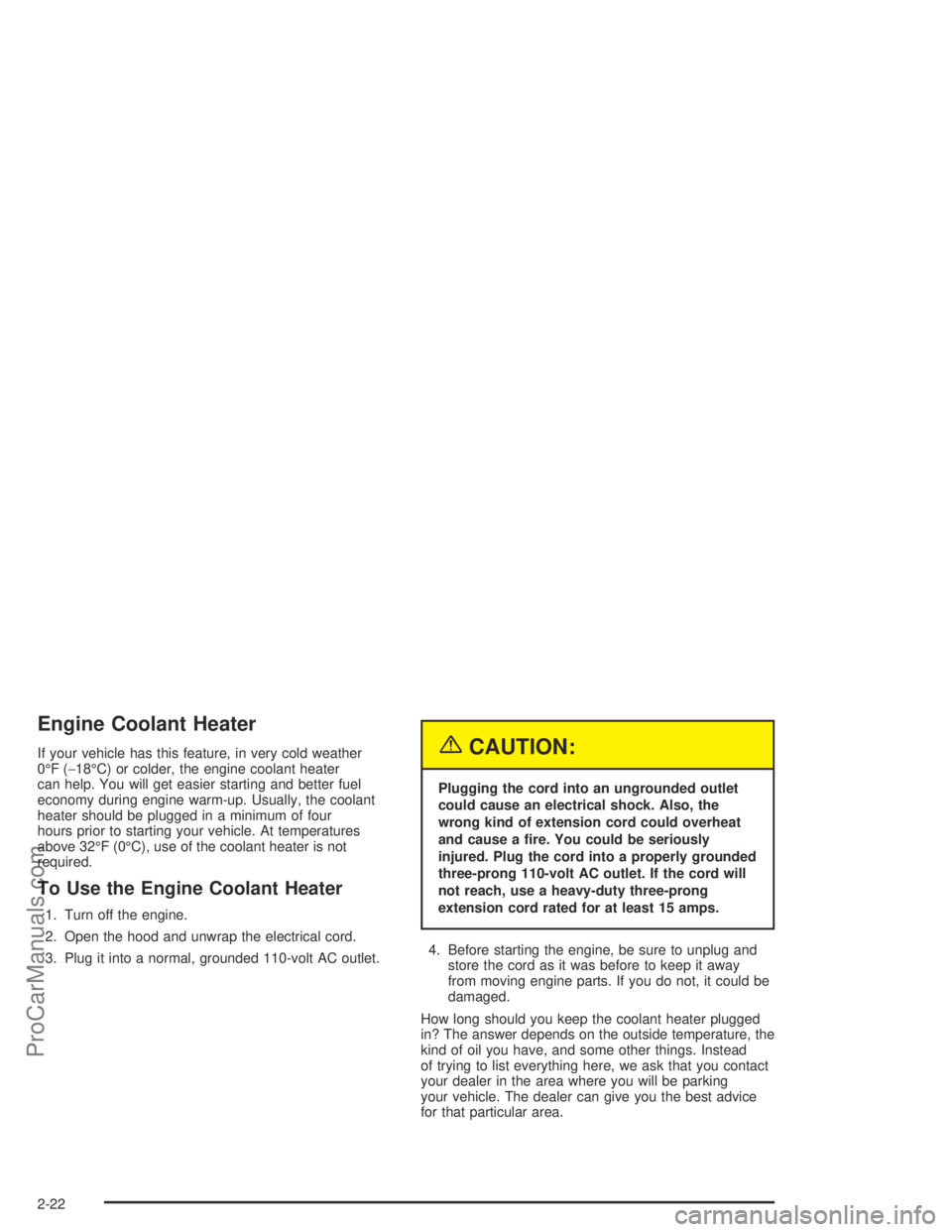
Engine Coolant Heater
If your vehicle has this feature, in very cold weather
0°F (−18°C) or colder, the engine coolant heater
can help. You will get easier starting and better fuel
economy during engine warm-up. Usually, the coolant
heater should be plugged in a minimum of four
hours prior to starting your vehicle. At temperatures
above 32°F (0°C), use of the coolant heater is not
required.
To Use the Engine Coolant Heater
1. Turn off the engine.
2. Open the hood and unwrap the electrical cord.
3. Plug it into a normal, grounded 110-volt AC outlet.
{CAUTION:
Plugging the cord into an ungrounded outlet
could cause an electrical shock. Also, the
wrong kind of extension cord could overheat
and cause a �re. You could be seriously
injured. Plug the cord into a properly grounded
three-prong 110-volt AC outlet. If the cord will
not reach, use a heavy-duty three-prong
extension cord rated for at least 15 amps.
4. Before starting the engine, be sure to unplug and
store the cord as it was before to keep it away
from moving engine parts. If you do not, it could be
damaged.
How long should you keep the coolant heater plugged
in? The answer depends on the outside temperature, the
kind of oil you have, and some other things. Instead
of trying to list everything here, we ask that you contact
your dealer in the area where you will be parking
your vehicle. The dealer can give you the best advice
for that particular area.
2-22
ProCarManuals.com
Page 89 of 380

Automatic Transaxle Operation
Five-Speed Automatic and VTi Variable
If your vehicle is equipped with either the �ve-speed
automatic transaxle or the VTi variable automatic
transaxle, the shift lever is located on the console
between the seats.
There are several different positions for the automatic
transaxle.
PARK (P):This position locks your front wheels.
It’s the best position to use when you start your engine
because your vehicle can’t move easily.
{CAUTION:
It is dangerous to get out of your vehicle if the
shift lever is not fully in PARK (P) with the
parking brake �rmly set. Your vehicle can roll.
Do not leave your vehicle when the engine is
running unless you have to. If you have left
CAUTION: (Continued)
CAUTION: (Continued)
the engine running, the vehicle can move
suddenly. You or others could be injured.
To be sure your vehicle will not move, even
when you are on fairly level ground, always set
your parking brake and move the shift lever to
PARK (P). SeeShifting Into Park (P) (Automatic
Transaxle) on page 2-31. If you are pulling a
trailer, seeTowing a Trailer on page 4-39.
Ensure the shift lever is fully in PARK (P) before starting
the engine. Your vehicle has an automatic transaxle shift
lock control system. You have to fully apply your regular
brakes before you can shift from PARK (P) when the
ignition key is in RUN. If you cannot shift out of PARK (P),
ease pressure on the shift lever – push the shift lever all
the way into PARK (P) and also release the shift lever
button as you maintain brake application. Then move the
shift lever into the gear you wish. Press the shift lever
button before moving the shift lever. SeeShifting Out of
Park (P) (Automatic Transaxle) on page 2-33.
2-23
ProCarManuals.com
Page 90 of 380
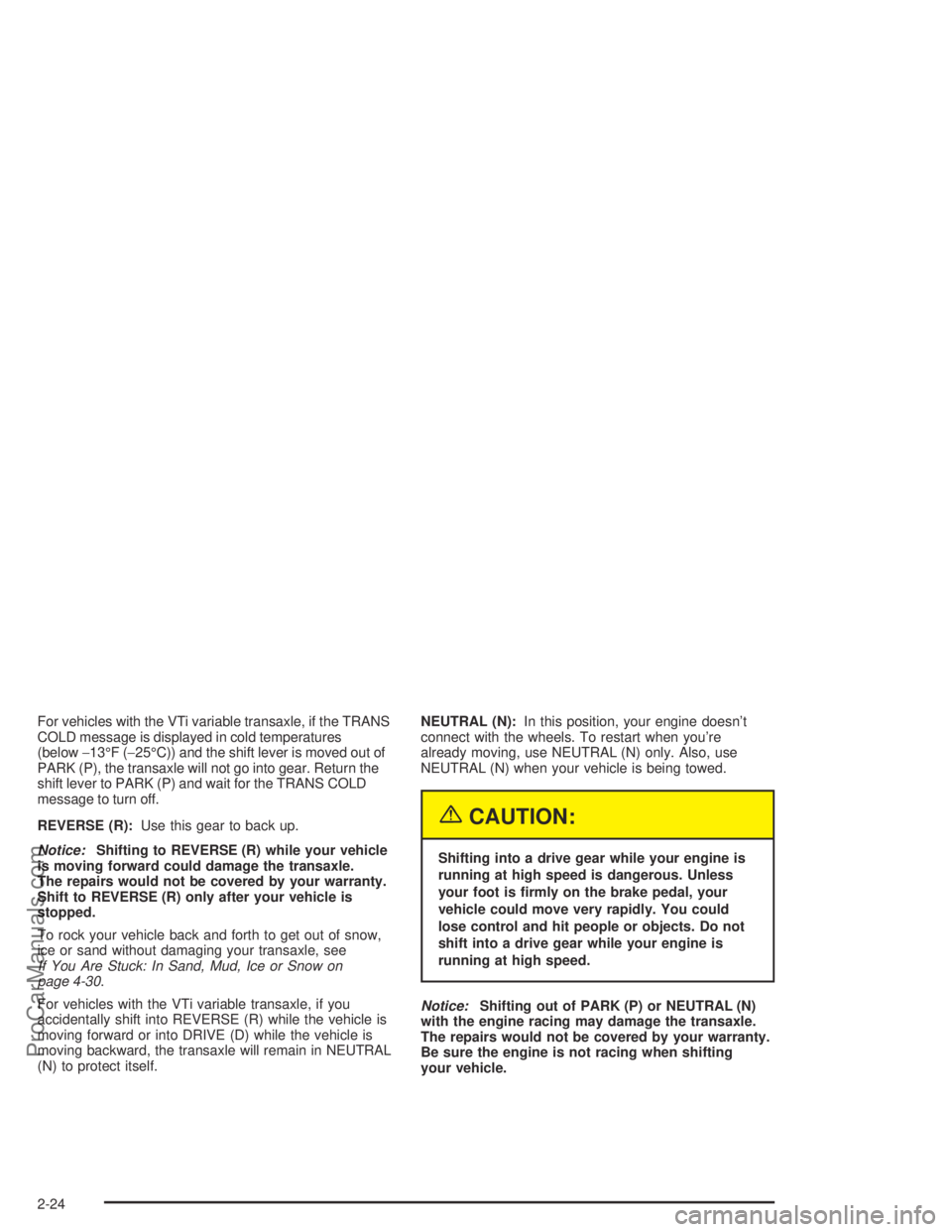
For vehicles with the VTi variable transaxle, if the TRANS
COLD message is displayed in cold temperatures
(below−13°F (−25°C)) and the shift lever is moved out of
PARK (P), the transaxle will not go into gear. Return the
shift lever to PARK (P) and wait for the TRANS COLD
message to turn off.
REVERSE (R):Use this gear to back up.
Notice:Shifting to REVERSE (R) while your vehicle
is moving forward could damage the transaxle.
The repairs would not be covered by your warranty.
Shift to REVERSE (R) only after your vehicle is
stopped.
To rock your vehicle back and forth to get out of snow,
ice or sand without damaging your transaxle, see
If You Are Stuck: In Sand, Mud, Ice or Snow on
page 4-30.
For vehicles with the VTi variable transaxle, if you
accidentally shift into REVERSE (R) while the vehicle is
moving forward or into DRIVE (D) while the vehicle is
moving backward, the transaxle will remain in NEUTRAL
(N) to protect itself.NEUTRAL (N):In this position, your engine doesn’t
connect with the wheels. To restart when you’re
already moving, use NEUTRAL (N) only. Also, use
NEUTRAL (N) when your vehicle is being towed.
{CAUTION:
Shifting into a drive gear while your engine is
running at high speed is dangerous. Unless
your foot is �rmly on the brake pedal, your
vehicle could move very rapidly. You could
lose control and hit people or objects. Do not
shift into a drive gear while your engine is
running at high speed.
Notice:Shifting out of PARK (P) or NEUTRAL (N)
with the engine racing may damage the transaxle.
The repairs would not be covered by your warranty.
Be sure the engine is not racing when shifting
your vehicle.
2-24
ProCarManuals.com